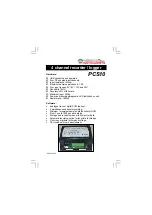
Modbus Protocol
Default is RTU. There are two protocols available to the user, RTU and ASCII.
In RTU mode a compatible Modbus master device must generate messages, as strict
timing is required for a successful communication. This mode allows for better data
throughput than ASCII mode for the same baud rate.
In ASCII mode, the user may connect to the device using a serial communication
program (i.e. HyperTerminal or ProComm) set to 7 data bits and 1 stop bit. Messages
can then be sent to the unit by typing the proper command. Each command is prefixed
with a ‘:’ and ended with a carriage-return / line-feed (<CR><LF> usually just the ‘Enter’
key). This mode offers much less throughput than RTU since 2 ASCII characters are
required to describe a single binary byte (e.g., the value 0xB5 would be communicated by
sending the ASCII characters ‘B’ and ‘5’). Since a Cyclic Redundancy Check (CRC) is
required on each message, the ability to send the message via HyperTerminal is almost of
no use unless the CRC can be generated by the user.
Note:
Care must be taken to make sure the selected protocol matches that of the master or
there will be communication problems.
Modbus Parity
Default is Even. Available choices include Even, Odd and None.
Note:
Care must be taken to make sure the selected parity matches that of the master or
there will be communication problems.
Modbus Delay before Tx
Default is 10ms. This identifies the number of milliseconds to wait after asserting CTS
before starting data transmission. This is useful if the device is connected to a radio
requires keying initialization before data transmission. The possible delay ranges are
10ms – 2000ms.
Modbus Delay after Tx
Default is 10ms. This identifies the number of milliseconds to wait after data
transmission is complete before de-asserting CTS. This is useful if the device is
connected to a radio that requires a hold-off time after data transmission has completed.
The possible delay ranges are 10ms – 2000ms.
Modbus Baud Rate
Default is 19.2 Kbps. Available communication speeds range from 1200bps – 115 Kbps.
Note:
Care must be taken to make sure the selected speed matches that of the master or
there will be communication problems.
69












































